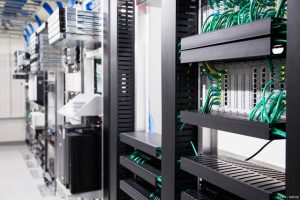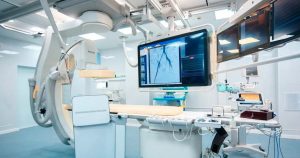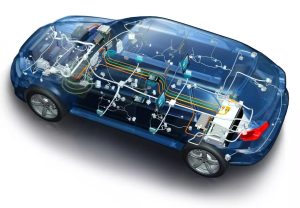“Powering the Digital World: Integrated Circuits for Seamless Connectivity and Innovation”
Wprowadzenie
Integrated circuits (ICs) are fundamental components in modern electronics, serving as the building blocks for a wide array of devices and systems. They are used to perform a variety of functions, including amplification, signal processing, data storage, and computation. ICs are found in everyday consumer electronics such as smartphones, computers, and televisions, as well as in more specialized applications like medical devices, automotive systems, and industrial machinery. Their ability to integrate numerous electronic components into a single, compact chip has revolutionized technology, enabling the development of smaller, more efficient, and more powerful electronic devices.
Enhancing Communication Devices
Integrated circuits, often referred to as ICs or microchips, have revolutionized the field of electronics, particularly in enhancing communication devices. These tiny, yet powerful components are the backbone of modern communication technology, enabling devices to perform complex tasks with remarkable efficiency and reliability. Integrated circuits are used in a myriad of ways to improve the functionality, performance, and versatility of communication devices, making them indispensable in our interconnected world.
One of the primary applications of integrated circuits in communication devices is in signal processing. Signal processing is crucial for the transmission and reception of data, whether it be voice, video, or text. Integrated circuits are designed to handle these tasks with precision, ensuring that signals are transmitted clearly and without distortion. For instance, in mobile phones, ICs manage the conversion of analog signals to digital signals and vice versa, facilitating seamless communication between devices. This capability is essential for maintaining the quality and integrity of the data being transmitted.
Moreover, integrated circuits play a vital role in the miniaturization of communication devices. As technology advances, there is a growing demand for smaller, more portable devices that do not compromise on performance. Integrated circuits allow for the integration of multiple functions into a single chip, significantly reducing the size and weight of communication devices. This miniaturization has led to the development of compact smartphones, tablets, and wearable devices that are both powerful and convenient to use. The ability to pack more functionality into smaller spaces has also paved the way for innovative designs and new form factors in communication technology.
In addition to miniaturization, integrated circuits contribute to the energy efficiency of communication devices. Power consumption is a critical factor in the design and operation of these devices, particularly for battery-powered gadgets like smartphones and laptops. Integrated circuits are engineered to optimize power usage, ensuring that devices can operate for extended periods without frequent recharging. This energy efficiency is achieved through advanced design techniques and the use of low-power components, which help to extend battery life and reduce the overall energy footprint of communication devices.

Furthermore, integrated circuits enhance the connectivity of communication devices. In today’s digital age, the ability to connect to various networks and devices is paramount. Integrated circuits enable communication devices to support multiple communication protocols, such as Wi-Fi, Bluetooth, and cellular networks. This multi-protocol support allows devices to seamlessly connect and communicate with each other, facilitating the exchange of information and enhancing the user experience. For example, a smartphone equipped with integrated circuits can effortlessly switch between Wi-Fi and cellular networks, ensuring uninterrupted connectivity regardless of the user’s location.
Security is another critical aspect where integrated circuits make a significant impact. With the increasing reliance on communication devices for personal and professional use, ensuring the security of data transmission is paramount. Integrated circuits incorporate advanced encryption and authentication mechanisms to protect data from unauthorized access and cyber threats. These security features are essential for safeguarding sensitive information and maintaining the privacy and integrity of communication.
In conclusion, integrated circuits are fundamental to the advancement and enhancement of communication devices. Their role in signal processing, miniaturization, energy efficiency, connectivity, and security underscores their importance in the modern world. As technology continues to evolve, integrated circuits will undoubtedly remain at the forefront, driving innovation and enabling the development of more sophisticated and efficient communication devices. The impact of integrated circuits on communication technology is profound, and their contributions will continue to shape the future of how we connect and communicate.
Revolutionizing Medical Equipment
Integrated circuits, often referred to as microchips or ICs, have revolutionized numerous industries, and their impact on medical equipment is particularly profound. These tiny, complex assemblies of electronic components have enabled the development of advanced medical devices that are more efficient, reliable, and capable than ever before. The integration of ICs into medical technology has not only enhanced diagnostic and therapeutic capabilities but also significantly improved patient outcomes.
One of the most notable applications of integrated circuits in medical equipment is in imaging technologies. Devices such as MRI machines, CT scanners, and ultrasound systems rely heavily on ICs to process the vast amounts of data they generate. Integrated circuits facilitate the rapid and accurate conversion of analog signals to digital data, which is essential for producing high-resolution images. This capability allows healthcare professionals to diagnose conditions with greater precision, leading to more effective treatment plans.
In addition to imaging, integrated circuits play a crucial role in patient monitoring systems. These systems, which include devices like ECG monitors, blood pressure monitors, and pulse oximeters, continuously track vital signs and other critical health parameters. The use of ICs in these devices ensures that data is collected and processed in real-time, providing healthcare providers with immediate insights into a patient’s condition. This real-time monitoring is particularly vital in critical care settings, where timely interventions can be life-saving.
Furthermore, integrated circuits have been instrumental in the development of wearable medical devices. These devices, such as fitness trackers and smartwatches, are equipped with sensors that monitor various health metrics, including heart rate, activity levels, and sleep patterns. The miniaturization of ICs has made it possible to incorporate sophisticated monitoring capabilities into compact, user-friendly devices. This advancement has empowered individuals to take a more proactive role in managing their health and has facilitated remote patient monitoring, reducing the need for frequent hospital visits.

Another significant application of integrated circuits in medical equipment is in the field of therapeutic devices. For instance, ICs are integral to the functioning of implantable devices like pacemakers and insulin pumps. These devices require precise control and reliable operation to ensure patient safety and efficacy. Integrated circuits provide the necessary computational power and control mechanisms to regulate these devices accurately. In the case of pacemakers, ICs help maintain a stable heart rhythm by delivering electrical impulses at the right moments. Similarly, insulin pumps use ICs to deliver precise doses of insulin, helping individuals with diabetes manage their blood sugar levels effectively.
Moreover, integrated circuits have enabled advancements in robotic surgery. Surgical robots, which assist surgeons in performing minimally invasive procedures, rely on ICs for their control systems. These systems ensure precise movements and enhance the surgeon’s ability to perform complex tasks with greater accuracy and dexterity. The use of ICs in robotic surgery has led to reduced recovery times, minimized surgical risks, and improved patient outcomes.
In conclusion, the integration of integrated circuits into medical equipment has brought about a paradigm shift in healthcare. From enhancing diagnostic imaging and patient monitoring to enabling wearable devices and advanced therapeutic solutions, ICs have become indispensable in modern medicine. Their ability to process data rapidly, control complex systems, and operate reliably has paved the way for innovations that continue to transform patient care. As technology continues to evolve, the role of integrated circuits in medical equipment is likely to expand further, driving even more significant advancements in healthcare.
Powering Consumer Electronics
Integrated circuits, often referred to as ICs or microchips, are the cornerstone of modern consumer electronics. These tiny, complex assemblies of electronic components have revolutionized the way we interact with technology, enabling the development of devices that are smaller, faster, and more efficient than ever before. The role of integrated circuits in powering consumer electronics cannot be overstated, as they are integral to the functionality and performance of a wide array of gadgets that have become indispensable in our daily lives.
To begin with, integrated circuits are essential in the operation of smartphones, which are arguably the most ubiquitous consumer electronic devices today. These microchips manage everything from processing power to memory storage, enabling smartphones to perform a multitude of tasks simultaneously. The central processing unit (CPU) and the graphics processing unit (GPU) within a smartphone are both examples of integrated circuits that work in tandem to deliver seamless user experiences, whether one is browsing the internet, playing games, or using complex applications.
Moreover, integrated circuits play a crucial role in the functionality of personal computers and laptops. The microprocessors within these devices are responsible for executing instructions and performing calculations at incredible speeds, making it possible for users to run sophisticated software, engage in high-definition video editing, and enjoy immersive gaming experiences. Additionally, integrated circuits are used in memory modules, such as RAM and SSDs, which are vital for the storage and quick retrieval of data, further enhancing the performance and efficiency of these machines.

Transitioning to another significant application, integrated circuits are also fundamental in the realm of home entertainment systems. Televisions, for instance, rely on microchips to process video and audio signals, ensuring high-quality playback and the ability to stream content from various sources. Similarly, gaming consoles are equipped with powerful integrated circuits that handle complex graphics rendering and real-time processing, providing gamers with smooth and responsive gameplay.
Furthermore, integrated circuits are indispensable in the development of wearable technology, such as smartwatches and fitness trackers. These devices require compact and energy-efficient microchips to monitor various health metrics, track physical activity, and provide notifications, all while maintaining a long battery life. The miniaturization of integrated circuits has made it possible to incorporate advanced functionalities into these small, portable devices, making them an integral part of modern health and fitness regimes.
In addition to these applications, integrated circuits are also found in household appliances, enhancing their efficiency and functionality. Modern refrigerators, washing machines, and microwaves are equipped with microchips that enable features such as temperature control, automated cycles, and energy-saving modes. This integration of advanced electronics into everyday appliances has not only improved their performance but also contributed to greater convenience and energy efficiency in our homes.
As we look to the future, the importance of integrated circuits in consumer electronics is set to grow even further. The advent of the Internet of Things (IoT) and the increasing prevalence of smart home devices will rely heavily on the capabilities of microchips to connect, communicate, and process data seamlessly. From smart thermostats to voice-activated assistants, integrated circuits will continue to be at the heart of innovations that enhance our quality of life.
In conclusion, integrated circuits are the driving force behind the functionality and advancement of consumer electronics. Their ability to perform complex tasks efficiently and reliably has enabled the development of a wide range of devices that have become essential in our daily lives. As technology continues to evolve, the role of integrated circuits will undoubtedly expand, paving the way for even more groundbreaking innovations in the world of consumer electronics.
Advancing Automotive Technology
Integrated circuits, often referred to as ICs or microchips, have become the cornerstone of modern automotive technology, driving advancements that were once the stuff of science fiction. These tiny, yet powerful components are embedded in virtually every aspect of a vehicle, from the engine control units to the infotainment systems, and their influence continues to expand as the automotive industry evolves. The integration of ICs into automotive technology has not only enhanced the performance and safety of vehicles but has also paved the way for innovations such as autonomous driving and advanced driver-assistance systems (ADAS).
One of the primary applications of integrated circuits in automotive technology is in engine control units (ECUs). These microchips are responsible for managing the engine’s performance by controlling fuel injection, ignition timing, and emission systems. By precisely regulating these parameters, ICs help optimize fuel efficiency, reduce emissions, and improve overall engine performance. This level of control was unimaginable in the early days of automotive engineering, but today, it is a standard feature in modern vehicles, thanks to the advancements in integrated circuit technology.

In addition to engine management, integrated circuits play a crucial role in enhancing vehicle safety. Modern cars are equipped with a plethora of sensors and systems designed to protect passengers and prevent accidents. For instance, anti-lock braking systems (ABS) and electronic stability control (ESC) rely on ICs to process data from wheel speed sensors and adjust braking force accordingly. This rapid processing capability ensures that the vehicle remains stable and under control, even in challenging driving conditions. Furthermore, airbag deployment systems use ICs to detect collisions and deploy airbags within milliseconds, providing an essential layer of protection for occupants.
The rise of autonomous driving technology is another area where integrated circuits are making a significant impact. Self-driving cars rely on a complex network of sensors, cameras, and radar systems to navigate and make real-time decisions. Integrated circuits serve as the brains behind these systems, processing vast amounts of data to interpret the vehicle’s surroundings and determine the best course of action. This level of computational power and efficiency is crucial for the safe and reliable operation of autonomous vehicles, and ongoing advancements in IC technology continue to push the boundaries of what is possible in this field.
Moreover, integrated circuits are at the heart of advanced driver-assistance systems (ADAS), which are designed to enhance the driving experience and improve safety. Features such as adaptive cruise control, lane-keeping assist, and automatic emergency braking rely on ICs to monitor the vehicle’s environment and provide timely interventions. These systems not only make driving more convenient but also significantly reduce the risk of accidents by assisting drivers in maintaining control of their vehicles.
The integration of ICs into automotive technology extends beyond performance and safety enhancements. Modern vehicles are equipped with sophisticated infotainment systems that offer navigation, entertainment, and connectivity features. Integrated circuits enable these systems to deliver high-quality audio and video, seamless connectivity with smartphones, and real-time navigation updates. As a result, drivers and passengers can enjoy a more connected and enjoyable driving experience.
In conclusion, integrated circuits have revolutionized the automotive industry by enabling a wide range of advancements in vehicle performance, safety, and convenience. From engine control units to autonomous driving systems, these microchips are the driving force behind the technological innovations that define modern vehicles. As the automotive industry continues to evolve, the role of integrated circuits will undoubtedly expand, paving the way for even more groundbreaking developments in the future.
Enabling Industrial Automation
Integrated circuits, often referred to as ICs or microchips, have revolutionized the landscape of industrial automation, serving as the backbone of modern manufacturing and production processes. These tiny yet powerful components integrate a multitude of electronic functions into a single chip, enabling the automation of complex tasks that were once manually intensive and error-prone. As industries strive for higher efficiency, precision, and reliability, integrated circuits have become indispensable in achieving these goals.
One of the primary applications of integrated circuits in industrial automation is in the control systems that manage machinery and production lines. Programmable logic controllers (PLCs), which are the workhorses of industrial automation, rely heavily on ICs to execute a wide range of functions, from simple relay control to complex process automation. These controllers use integrated circuits to process inputs from sensors, execute programmed instructions, and control outputs to actuators, ensuring that machinery operates seamlessly and efficiently. The precision and reliability of ICs make them ideal for these applications, where even minor errors can lead to significant downtime and financial losses.

Moreover, integrated circuits play a crucial role in the development of advanced robotics, which are increasingly being deployed in industrial settings. Robots equipped with ICs can perform tasks such as assembly, welding, painting, and material handling with high accuracy and consistency. The integration of microcontrollers and microprocessors within these robots allows for real-time processing of data and adaptive control, enabling them to respond to changes in the environment and perform complex tasks with minimal human intervention. This not only enhances productivity but also improves workplace safety by reducing the need for human workers to perform hazardous tasks.
In addition to control systems and robotics, integrated circuits are essential in the realm of industrial communication networks. Modern factories rely on robust communication systems to ensure that various components of the production process are synchronized and operating in harmony. ICs facilitate the implementation of communication protocols such as Ethernet, Modbus, and Profibus, which are used to connect sensors, actuators, and controllers across the factory floor. These communication networks enable real-time data exchange and monitoring, allowing for predictive maintenance, process optimization, and rapid response to any anomalies that may arise.
Furthermore, integrated circuits are pivotal in the development of smart sensors, which are integral to the concept of the Industrial Internet of Things (IIoT). Smart sensors equipped with ICs can collect and process data at the source, providing valuable insights into the condition and performance of machinery. This data can be used to optimize production processes, reduce energy consumption, and predict equipment failures before they occur. The ability of ICs to handle complex signal processing and data analysis makes them ideal for these applications, driving the adoption of IIoT technologies in various industries.
As we look to the future, the role of integrated circuits in industrial automation is set to expand even further. Advances in semiconductor technology are leading to the development of more powerful and energy-efficient ICs, which will enable even greater levels of automation and intelligence in industrial systems. From artificial intelligence and machine learning to edge computing and 5G connectivity, integrated circuits will continue to be at the forefront of innovation, driving the next wave of industrial transformation.
In conclusion, integrated circuits are the linchpin of industrial automation, enabling the precise control, advanced robotics, robust communication networks, and smart sensors that define modern manufacturing. Their ability to integrate multiple functions into a compact and reliable form factor makes them indispensable in the quest for higher efficiency, productivity, and safety in industrial environments. As technology continues to evolve, the importance of integrated circuits in industrial automation will only grow, paving the way for a smarter and more connected industrial future.
Supporting Space Exploration
Integrated circuits, often referred to as microchips or ICs, are fundamental components in modern electronics, playing a pivotal role in supporting space exploration. These tiny, yet powerful devices integrate a multitude of electronic components such as transistors, resistors, and capacitors onto a single silicon chip, enabling complex functionalities within a compact form factor. The significance of integrated circuits in space exploration cannot be overstated, as they are integral to the operation of spacecraft, satellites, and various other space-bound instruments.
One of the primary applications of integrated circuits in space exploration is in the realm of communication systems. Spacecraft and satellites rely heavily on robust communication links to transmit data back to Earth and receive commands from mission control. Integrated circuits facilitate the processing and modulation of signals, ensuring that data can be transmitted over vast distances with minimal loss of integrity. This capability is crucial for maintaining continuous and reliable communication, which is essential for the success of any space mission.

In addition to communication, integrated circuits are indispensable in the navigation and control systems of spacecraft. These systems require precise and real-time processing of data from various sensors to determine the spacecraft’s position, orientation, and trajectory. Integrated circuits enable the rapid computation and analysis of this data, allowing for accurate navigation and control. This precision is vital for tasks such as docking with the International Space Station, landing on celestial bodies, and executing complex maneuvers in space.
Moreover, integrated circuits play a critical role in the scientific instruments carried aboard space missions. These instruments are designed to gather data about the environment, such as temperature, radiation levels, and the presence of specific elements or compounds. Integrated circuits process the raw data collected by these instruments, converting it into meaningful information that can be analyzed by scientists. This capability has led to numerous groundbreaking discoveries, from the detection of water on Mars to the observation of distant galaxies.
Furthermore, the reliability and durability of integrated circuits are paramount in the harsh conditions of space. Spacecraft are exposed to extreme temperatures, radiation, and vacuum, all of which can adversely affect electronic components. Integrated circuits used in space missions are specially designed and rigorously tested to withstand these conditions, ensuring that they can operate reliably over extended periods. This robustness is essential for the longevity and success of space missions, which often span several years.
In addition to their technical capabilities, integrated circuits also contribute to the miniaturization of space technology. The compact size of integrated circuits allows for the development of smaller and lighter spacecraft, which can reduce launch costs and increase the payload capacity. This miniaturization has enabled the proliferation of small satellites, known as CubeSats, which are used for a variety of purposes, including Earth observation, scientific research, and technology demonstration.
In conclusion, integrated circuits are indispensable to the advancement of space exploration. Their applications in communication, navigation, scientific instrumentation, and miniaturization have revolutionized the way we explore and understand the cosmos. As technology continues to evolve, integrated circuits will undoubtedly play an even more significant role in future space missions, paving the way for new discoveries and expanding our horizons beyond Earth.
Wnioski
Integrated circuits are used in a wide range of applications including computers, smartphones, medical devices, automotive systems, industrial machinery, and consumer electronics. They serve as the fundamental building blocks for modern electronic devices, enabling complex functionalities such as data processing, signal amplification, power management, and digital communication. Their compact size, reliability, and efficiency have revolutionized technology, making advanced electronic systems more accessible and affordable.
